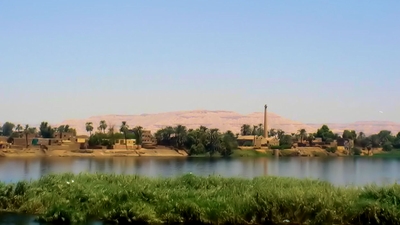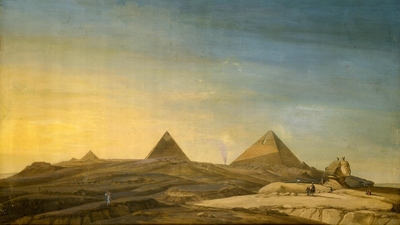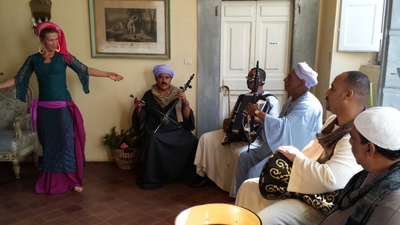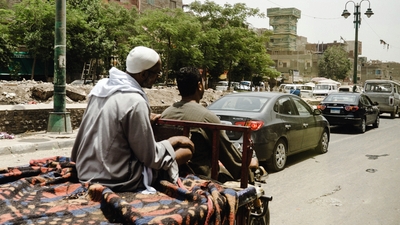The Arab Republic of Egypt is a country located in North-East Africa that has the distinction of having part of its territory in the Middle East, the Sinai region. Characterized by an essentially desert territory, it is crossed by the longest river in Africa, the Nile, a true cordon linking the different regions of the country and along which lives the bulk of the population.
With a population of 96 million inhabitants for about 1 million square kilometers, its density is very different between the desert and urban areas, the latter developing at high speed. The political regime of Egypt is the Republic. The country has been independent since February 28, 1922.
One of the characteristics of Egypt is the length of its history. Beginning as early as 3200 BC, at the time of the unification of the peoples of the Nile delta and those of Nubia, the civilization that will emerge from this merger will experience three empires separated by intermediate periods of weakening or disappearance of central power , before being phagocyted by the Roman Empire, during antiquity. This exceptional longevity is enhanced by the existence, even today, of many testimonies of this distant time of which the pyramids are the best known witnesses.
A certain vision of modern Egypt ...
With its uninterrupted lines of cars, its taxis and modern buildings, the city of Cairo, the capital of Egypt, today causes a feeling of suffocation. Garbage management has become a critical issue in a city that today has more than 16 million inhabitants and continues to grow.
In the midst of honking concerts, however, there is still a traditional Cairo whose charm is tamed by the strolls in the old neighborhoods. Carts of fruits and vegetables still circulate in the same narrow lanes and the small picturesque crafts that made the happiness of the orientalist writers of the nineteenth century still exercised: lemonade, shoeshine, manufacturers of mats or baskets, meals or tinsmith ... Come to marvel at the pyramids and treasure of Tutankhamun at the Egyptian Museum in Cairo, the visitor too often forgets to dwell on the wonders of Islamic architecture. The mosques succeed the caravanserais, the minarets compete with finesse and balance. A real history lesson in a capital that has become a flagship city in the bustle of the contemporary Arab world.
Without the Nile, the father of the rivers, eternal and nourishing, Egypt would be but an immense expanse of desert. It is therefore naturally on its banks that life has developed since prehistory and that the architects of the Pharaohs have built temples and tombs. In 1828, Champollion and his team went up the river to Abu Simbel aboard a mâasch and a dahabieh - a former Mamluk barque boat of which we can still see some models sailing on the Nile. In their wake, the rich travelers of the nineteenth century borrowed the same type of boat to discover in turn the wonders of antiquity. The precarious comfort of these solitary cruises has now given way to large modern units.
In the absence of a dip in the waters of the Nile, strongly discouraged, we refresh in the pool on the deck. But the charm remains intact and all those who made the trip claim, a cruise on the Nile resembles the projection of a long film whose scenes are borrowed from the pharaonic daily. How not to be seized, indeed, when one observes the fellahs, the Egyptian peasants handling the selouka, this hoe with broad blade that the artists of the New empire (1539-1069 before JC) had already painted with talent on the walls of the temples ...
In the morning, the children take their bath in the waters of the river, not hesitating to soap camels or donkeys. The women talk while washing their colorful linen on the banks. The fishermen are trying to catch boltis, the fatty perch that the Egyptians love. With the help of a heavy stick, the body half immersed, a young boy strikes the waters to fold the precious fish in the nets.
Abydos, Dendera, Luxor, Karnak, the Theban valley, Esna, Edfu, Kom Ombo, Kalabsha, the list would be long temples and necropolis of ancient Egypt that made the wonder of Champollion. Like him, one falls in awe at the 134 pillars of the hypostyle hall of the temple of Karnak, a veritable forest of columns. Like him, one can only compare oneself to Lilliputians who have noted that "no ancient or modern people have conceived the art of architecture on such a sublime, wide, grandiose scale." Like him, one is ecstatic about the bas-reliefs of the charming little island temple of Philae ... The archaeologist had however the advantage over the common travelers of today to read "as in an open book" the hieroglyphic texts engraved some three thousand years ago. After fifteen centuries of silence, these monuments spoke to him again. And what a proxility! It is enough to enter the Valley of the Nobles, necropolis of the West bank of the Nile in Luxor where are buried the dignitaries of the New Kingdom, to understand the fascination exerted by the Egyptian civilization. No people in the world have expressed themselves with so much talent and ardor, in images as in writing, and over such a long period. The emotion is great in front of the mourners immortalized on a wall of the tomb of Ramose who throw sand on the face to express their sorrow. Or in front of these elegant young disheveled girls who seem to be swaying on sustained rhythms in the tomb of Kherouef. In Sennefer, bunches of black grapes await picking while Rekhmire shows cabinet makers, painters and sculptors at work. If the visit of the tombs of the numbers evokes a light and carefree life, punctuated by the floods of the Nile, quite another is the impression felt in the burials of the pharaohs. Only decorated with scenes of religious nature, they present us an unknown world, sometimes hostile. This is the passage to life beyond the grave that the ancient Egyptians wanted to reach after their death.
Champollion, who drove passion to sleep in the tomb of Ramses IV, was without a doubt the first to measure the extent of their fascination with the afterlife, seeing in religion "the immutable base of the whole world." 'social organization'. The pharaohs took with them all the elements essential to their eternal life: food, furniture, amulets, chests and gold jewelery, statues ... On the walls of the tombs, the high priests had written "instructions" necessary for to penetrate into this infra-world: prayers, homage to the gods of the kingdom of the dead, formulas. Without the discovery of Tutankhamun's tomb, the only one to have escaped the looters of antiquity, one would probably ignore the existence of these underground treasures. When we know that this pharaoh died young and after a rather modest reign, it is hard to imagine what was to be the treasure of Ramses II who was at the head of the Kingdom of Egypt for 67 years ...
The most famous pharaoh left lavish traces in Thebes, the capital of Egypt known today as Luxor. The city was divided into two shores, that of the dead, to the west, which housed the necropolises and that of the living, to the east, which today concentrates the modern city. At Thebes was celebrated the worship of Amon-Re, an almighty and feared God.
Times have changed. The inhabitants are no longer afraid of what is happening behind the walls of the temple - apart from perhaps some sects claiming a solar god who regularly come on pilgrimage! But over the centuries, the Sphinx alley that connected the temple of Karnak to that of Luxor has disappeared. It is rumored that their occupants should soon be expelled to restore the prestigious road.
To the south, like an apotheosis, the temple of Abu Simbel, "Ipsambul" as it was called in the time of Champollion, arose in the middle of the Nubian desert, at the edge of the waters of Lake Nasser, which almost overwhelmed it. 1960 during the construction of the Aswan High Dam. The study of two papyri from the temple had enabled the Frenchman to confirm his hypotheses about hieroglyphs in 1822. It was therefore with emotion that he entered this seraglio of Egyptology. "The work that this excavation cost has frightened the imagination," noted the scientist, impressed by the immoderation of the building built by Ramses II. For the thousands of tourists who parade here every month, the shock remains the same in front of the facade of the big temple and its four colossal statues in the effigy of Pharaoh, directly carved into the cliff. The interior is, it is true, just as spectacular.























